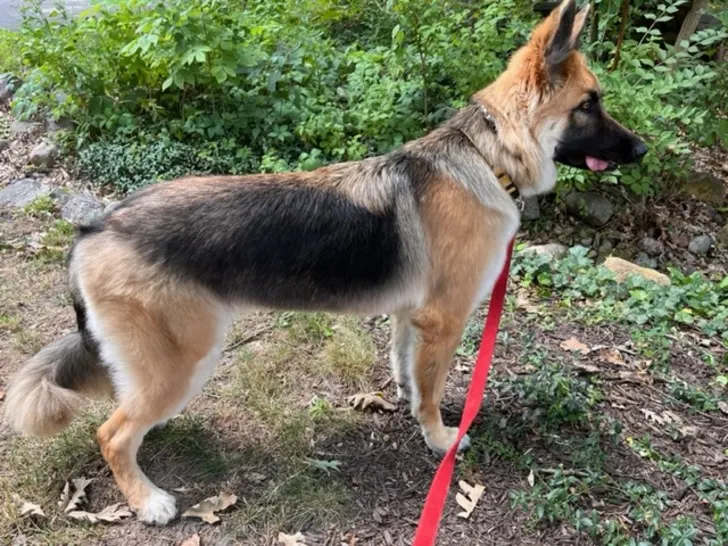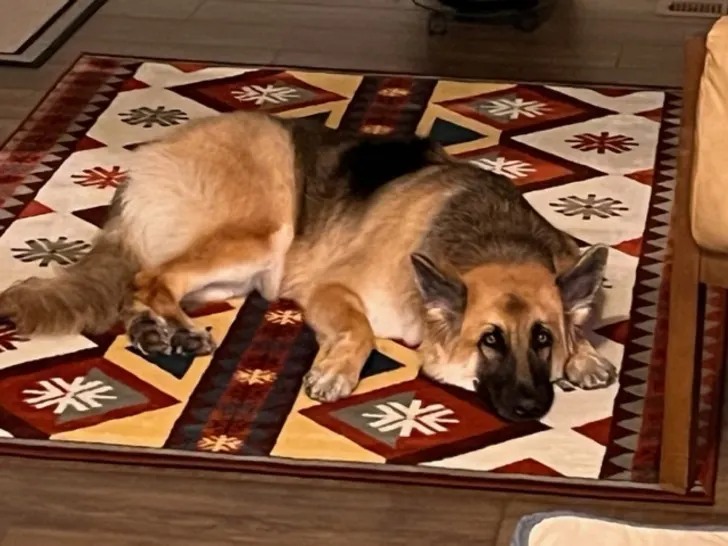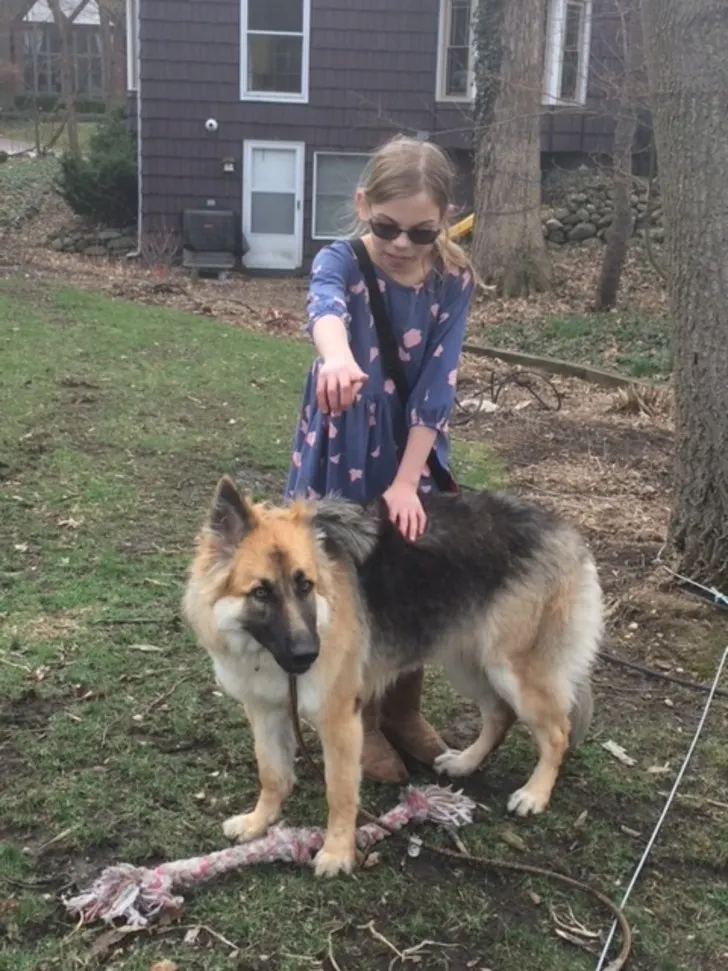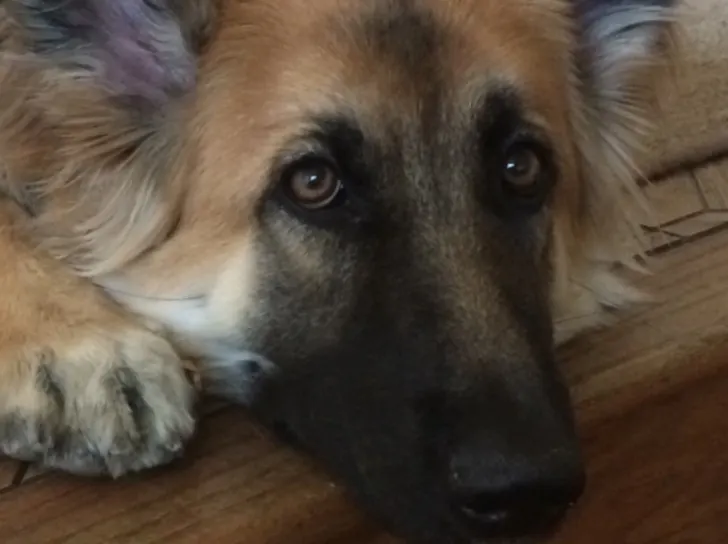Most people are familiar with the regular short-haired German Shepherd.
They are ranked as the second most popular dog in the United States.
People are not as familiar with the long-haired German Shepherd but are usually captivated when they see one for the first time.
These dogs are beautiful and inspire many questions from dog lovers.
Before choosing this breed, you need to know all about long-haired German Shepherds to assess if they are the right dog for you.

Long-haired German Shepherds are similar to short-haired German Shepherds. Their long coat occurs from a recessive gene passed on from both parents. They often have a softer temperament well-suited to a pet home. They need to be groomed two to three times a week and must receive training.
Long-haired German Shepherd puppies look like adorable teddy bears, but they have specific needs.
These needs must be met for there to be a happy dog-owner partnership.
Click Here to Jump to a Section
How Did The Long-haired German Shepherd Originate?
Long-haired German Shepherds have the same origin as short-haired German Shepherds.
In the early 1900s, people began trying to standardize dog breeds.
Max von Stephanitz was a dog lover who admired the German sheep herding dogs and wanted to establish a breed from them.
He found a dog named Hektor Linksrhein, who came from a selective breeding program which was an unusual practice at the time.
Von Stephanitz bought Hektor and renamed him Horand von Grafrath.
He started the first German Shepherd club and registered Horand as the first dog in the club.
Max began a breeding program to produce dogs similar to Horand.
This was the birth of German Shepherds as we know them today.
Some of these first dogs had long hair, and some had short hair.
Over time the short-haired variety predominated and became the most common German Shepherd seen in modern times.
Source: AKC
The Genetics Of Long-haired German Shepherds
To understand how long-haired German Shepherds are produced, you need to understand some basic genetic principles – don’t worry, we will keep it simple.
Every trait or characteristic is governed by a set of two genes – one donated by the father and one from the mother.
Genes may be dominant or recessive.
Dominant genes will always express or show themselves in the animal’s appearance, even if paired with a recessive gene.
Recessive genes will only be seen if they are paired with another recessive gene.
Short hair is a dominant gene in German Shepherds.
If a dog has a short-haired gene plus a long-haired gene, the dog’s coat will be short.
A German shepherd with long hair must have two long-haired genes inherited from its parents.
The reason that short-haired German Shepherds became the most common type was that the short-hair gene is dominant.
The dogs could still carry the long-haired gene, but it is not expressed because it is a recessive gene.
Source: Pawprint Genetics
Can Short-Haired Parents Produce Long-haired Pups?

Some people believe that long-haired German Shepherds are a ‘modern invention’ or not true German Shepherds. This is an incorrect belief.
Two short-haired German Shepherd parents may both be carrying a recessive long-haired gene. In this case, there is a 25% chance that the puppies will have long hair.
Some short-haired German shepherd parents do not carry the long-haired gene and, therefore, will not produce long-haired puppies.
Two long-haired German Shepherd parents will always produce long-haired puppies.
They only carry the long-haired gene, and all the puppies will have long coats.
Are Long-haired German Shepherds Rare?
Due to long hair being a recessive gene, German Shepherds with this coat length are rare.
For many years, long-haired German Shepherds were considered ineligible for registration by the various kennel unions.
Consequently, breeders did not breed long-haired dogs, and pups with long coats were often sold cheaper, given away, or even destroyed.
Some breeders have chosen to breed only long-haired German Shepherds, but they are in the minority.
Fortunately, times have changed, and German Shepherd breeders no longer destroy puppies with long coats if they are born to short-haired parents.
What Color Is A Long-haired German Shepherd’s Coat?
The most common color for long-haired German Shepherds is black and tan. The tan may vary from lemon or gold to a reddish brick color.
They may also be sable which is either all black or all grey with brown or lighter markings.
Bi-color dogs are predominantly black dogs with tan or gold markings on the chest, feet, and head.
The AKC disqualifies white, blue, liver, and albino dogs.
Although not recognized by the AKC, long-haired white German Shepherds are admired by dog lovers, and some breeders choose to breed these dogs for pet homes.
Can Long-haired German Shepherds Be Registered?
Long-haired German Shepherds can usually be registered with German Shepherd clubs or associations.
The American Kennel Club registers long-haired German Shepherds born from registered parents.
Although the dogs may be registered with AKC, they do not generally do well in the show ring as most judges view the longer coat as a fault and penalize the dog.

Long-haired German Shepherds may enter any AKC sports competition other than showing and will not be penalized.
The United Kingdom and German Kennel Clubs recognize and accept long-haired German Shepherds.
There is a move to change the judging rules so that long-haired German Shepherds are not penalized or disqualified in show judging.
All kennel clubs agree that long-haired German Shepherds must have a double coat.
An undercoat is found under the long guard hairs that form the topcoat.
The length of the top coat may vary in Long-haired German Shepherds so that some have a slightly longer coat and others a much longer coat.
Long-haired German Shepherds with no undercoat may be denied registration and automatically disqualified by any showing judge.
If you are looking for a pet, remember that having a long-haired German Shepherd without an undercoat will not affect the dog’s health or temperament in any way.
These dogs often have coats that look shiny, which many people find appealing.
How Big Are Long-haired German Shepherds?
Long-haired German Shepherds are big dogs.
Male shepherds measure 24 to 26 inches (60 to 66 cm) at the shoulder and weigh 65 to 90 pounds (29.6 to 41 kg).
Females are 22 to 24 inches (55 to 61 cm) and weigh 50 to 70 pounds (22 to 32 kg).
Source: AKC
What Is The Temperament Of Long-haired German Shepherds?
Long-haired German Shepherds are similar to their short-haired counterparts. They are loyal dogs that bond strongly with their owners.
They can be one-person dogs but will still protect the entire family if necessary.
A well-bred long-haired German Shepherd that is socialized early is an excellent dog with children.
These dogs want to be part of the family.
They do not do well when locked away from their owners in the backyard. Long-haired German Shepherds need a lot of attention.
An ideal family for long-haired German Shepherds has someone who is home for much of the day. They are also suited to people that want to take their dog to work with them.
Dogs separated from their family may show separation anxiety, resulting in destructive behaviors or attempts to escape the home.
These dogs are intelligent enough to figure out ways to open doors and gates, so escaping is not too much of a challenge for them.
Some breeders choose to breed with long-haired German Shepherds because the dogs have a softer temperament, better suited to pet homes.
This temperament developed because long-haired dogs were not usually accepted into working or show homes.
They did not need the intensity of drive required of a working dog or one bred for showing.
Similarly, breeders that bred occasional long-haired puppies were not usually that ambitious in the show ring or producing working dogs.
They tended to be breeding for pet homes, which showed in the dogs’ temperament.
The dogs became gentler and not as intense.
Do Long-Haired German Shepherds Have High Energy?

Long-haired German Shepherds are medium to high-energy dogs.
There are individual differences influenced by genetic inheritance.
If you are contemplating a long-haired German Shepherd, you need to do a careful audit of your energy and time to exercise your dog.
A long-haired German Shepherd is not the right dog for you if you prefer lazing in bed.
If you feel you could deal with a dog with moderate but not high energy needs, you must be selective in the breeder you choose.
Breeders should be able to tell you how much energy the dogs they breed usually need.
If the breeder says their dogs are high energy, do not be tempted if you can only cope with moderate energy levels in a dog.
Dogs with moderate energy levels need one hour of exercise daily for an adult dog.
Dogs with high energy levels need two or more hours of exercise as adults.
The UK Kennel Club describes most long-haired German Shepherds as high-energy dogs requiring daily intense exercise and stimulation.
Bear in mind that adolescent long-haired German Shepherds will need more exercise and stimulation than adults.
Young and adolescent German Shepherds must have their exercise carefully managed to prevent damage to their developing joints.
Running for miles at this stage is detrimental.
Intellectual stimulation can be combined with physical exercise to tire the dog out.
Scent training, problem-solving toys, and giving a dog a job are all good tasks for intellectual stimulation.
Long-haired German Shepherds are highly intelligent dogs that need mental stimulation.
An under-stimulated dog will think of his own entertainment, which you may not appreciate as it often involves the destruction of your prize garden or furniture.
Can A Long-haired German Shepherd Live In An Apartment?
Apartment life is not ideal for long-haired German Shepherds.
They usually need space to run and play. A garden allows them to interact with the outside world, providing much-needed stimulation.
If you live in an apartment and take your dog everywhere, a long-haired German Shepherd will fit in with your lifestyle.

Long-haired German Shepherds have loud barks and are vocal dogs.
You must ensure that your neighbors are not offended when your dog makes himself heard.
Some people use dog walkers to exercise their long-haired German Shepherds when they are not home at their apartment.
This arrangement is better suited for older dogs as young dogs will need more exercise and stimulation than what can be provided by one walk a day.
Doggy daycare centers have become increasingly popular with people that live in apartments but wish to own dogs.
This situation could work well if you wish to own a long-haired German Shepherd, live in an apartment, or cannot be home with your dog.
Remember that your long-haired German Shepherd will need to be well-socialized and acclimatized to this arrangement.
Dogs closely bonded with their owner may struggle to adjust to a daycare facility.
Ultimately it is better to have long-haired German Shepherds in a freestanding house with a large garden.
They are popular on farms as they are protective dogs that, if socialized with livestock, will protect the family and other farm animals.
Do Long-haired German Shepherds Need Training?
Long-haired German Shepherds are powerful, athletic dogs with formidable intelligence.
They must be trained and socialized from a young age.
The German Shepherd Dog Club of America recommends training your puppy from the time it comes home.
They give some tips on proactive training puppies and how to find the right help when you need it.
Every long-haired German Shepherd puppy should learn basic obedience.
You can begin its education from the time you get home with your puppy.
Once your Shepherd puppy is fully vaccinated, you can take your puppy to puppy and basic obedience classes.

Check with your vet when it is safe to go out with your puppy.
Long-haired German Shepherds excel at obedience and enjoy other dog sports such as agility, fly ball, and scent work.
Schutzhund (IGP) is a competitive sport where dogs must complete tracking, obedience, and protection tasks. Long-haired German Shepherds do well in this multi-disciplinary sport.
Long-haired German Shepherds should be trained using positive reinforcement.
These training methods have produced reliably obedient, happy dogs that enjoy their work and training.
Harsh training methods produce unstable dogs that may become anxious or aggressive.
Many dogs trained with punitive methods are unreliable in their response to people. When looking for a training school, select a trainer that uses positive reinforcement.
Long-haired German Shepherds are naturally protective and good guard dogs.
Some owners wish to use this instinct and do protection training with their dogs.
Unfortunately, many people, even some trainers, think that protection training should use harsh methods to ‘produce aggression in dogs so that they will protect their owners.
This thinking is outdated, unkind, and untrue.
Positive reinforcement and kind training methods can be used in protection training.
It is more effective with dogs that may be hesitant about this kind of work, and there are fewer ‘failed’ protection dogs using these methods.
Are Long-haired German Shepherds Prone To Disease?
Modern pedigreed dogs all have predispositions to certain diseases or conditions.
This has occurred because of the desire to standardize breeds and the inbreeding to achieve dogs that conform to the standard.
Responsible breeders are aware of the potential problems in long-haired German Shepherds and test the parent dogs before breeding to exclude the possibility of passing on health issues to the next generation.
Like most big dogs, long-haired German Shepherds are predisposed to joint problems.
The parent dogs must have their hips and elbows x-rayed and scored before breeding. Only dogs with good elbows and hips should be bred.
Elbow and hip dysplasia occur when the bones and cartilage grow abnormally, resulting in joints that do not fit together well.
Bones rub against each other and cartilage, destroying the joint.
In severe cases, this needs early surgery and may even result in euthanasia if too many of the dog’s joints are affected.
Mild dysplasia causes early-onset arthritis and will affect the dog’s exercise tolerance.
Degenerative myelopathy is an inherited condition in Long-haired German Shepherds with devastating consequences.
It affects the spinal cord and causes paralysis of the back legs and sometimes the front legs.
Long-haired German Shepherds can get a degenerative inherited condition that affects the cornea of their eyes.
This condition is known as pannus and is exacerbated by exposure to ultraviolet rays, such as occurs in high-altitude environments.
Pannus can be treated if it is detected early.
Gastric dilation and volvulus (GDV) is a common condition of large breed dogs, and long-haired German Shepherds are also at risk.
It is colloquially known as bloat and torsion.
Air becomes trapped in the stomach causing swelling or bloat in the stomach. The stomach twists, causing torsion.
This condition is extremely painful and dangerous.
Dogs can die within an hour of this condition developing.
It is a medical emergency, and the dog should immediately be rushed to the vet.
Immediate surgery can correct the problem.
Vets generally stitch the stomach to the abdominal wall to prevent reoccurrence.
Although German Shepherds are prone to this condition, it is not a genetic condition, and there is no way to test for it.
The best way to avoid GDV is to practice good feeding habits.
Dogs should be fed from slow feeders and should not exercise for 30 to 60 minutes before or after eating.
Some vets recommend that the food bowl be lifted off the ground so the dog does not bend its head down to the ground while eating.
Food that encourages bloating should be avoided.
Source: Purina Health
What Should I Feed My Long-haired German Shepherd?
Choose a food appropriate for a large breed dog. It should have high protein levels and not include fillers, artificial colorants, or flavors.
Preservatives should be kept as natural as possible. It is impossible to have preservative-free food with any shelf life.

The food should include omega oils which are excellent for the skin and coat of a long-haired German Shepherd. Chondroitin and glucosamine provide joint support for this large breed dog.
Numerous studies have found that offering your dog vegetables and fruit helps prevent diseases such as cancer. These can be used as treats instead of biscuits or added to food.
Find out 30 vegetables German Shepherds can eat.
It is also useful to know exactly what foods your German Shepherd can and can’t eat.
Long-haired German Shepherd puppies must be fed food appropriate for large breed dogs.
A decade ago, researchers thought that high protein was a problem for large-breed puppies, but recent research has shown that high-protein diets for puppies prevent many joint problems.
Choose a diet with high protein and no unnatural additives.
The puppy should be fed this until they are about 18 months old. You can monitor their development by comparing it to a weight and growth chart.
Source: Imprimedicine
Do Long-Haired German Shepherds Have Digestive Issues?
German Shepherds, both long and short-haired, are known for having digestive issues causing upset stomachs.
Some dog food brands have developed food specifically for German Shepherds. Sometimes your long-haired German Shepherd will eat grass when they have stomach discomfort.
If your long-haired German Shepherd is showing digestive and skin symptoms, they are probably allergic or intolerant to an ingredient in the food.
They may also have inflammatory bowel disease, which can be diagnosed by taking a biopsy of the gut.
There are many foods available currently for dogs with allergies.
It usually takes trial and error to determine what the dog is allergic to and find the most appropriate food.
Corn, soy, wheat, chicken, beef, and pork are the most common allergens.
Finding the appropriate diet for a dog with digestive issues requires lateral thinking and patience.
Many dog owners have found that feeding raw foods or home-cooked meals is best.
It is advisable to consult an animal nutritionist if you wish to explore these options.
Grooming Tips For A Long-haired German Shepherd
Before we go any further, let’s take a pause to watch the amazing Girl With The Dogs get her groom on!
This is a great example of what you can expect a properly groomed Long-haired German Sheperd to look like – and in her words:
“In my personal opinion, there is no dog quite comparable to the majestic and brilliant German Shepherd.”
Girl With The Dogs
We couldn’t agree more!
Long-haired German Shepherds should be brushed two to three times a week. Grooming regularly prevents knots and tangles and removes loose hair.
The double coat of most long-haired German Shepherds will be shed twice a year. Brushing may need to be increased during this time.
Slicker brushes and rakes are the best tools for undercoats and help to detangle and remove hair that is about to shed.
Dematter combs are excellent for matts that develop in the coat. A bristle brush or grooming glove can be used on the top coat.
Long-haired German Shepherds should only be washed every three to four months to prevent the natural coat oils from drying.
We personally vouch for the brushes listed below. These are tried and true, and we have used them on many a Long-haired German Shepherd!
The first brush we recommend is the Furminator. This brush is effective at reaching below your dog’s topcoat to access the stubborn undercoat which is responsible for oh so many clumps of hair around your house!
We also really like this brush because, unlike many others, it does not dig into your dogs delicate skin underneath their double coats.
That’s not to say you shouldn’t be mindful of your dog’s skin when brushing (please be very mindful!), but when used properly, this brush is a highly effective tool.
For brushing your dog’s long top coat, we prefer a simple grooming glove.
This one from Delomo does the trick quite well, and we find that they also work as a great bonding experience between you and your dog – much more so than your typical top coat rake brush.
We also love the added bonus of these gloves being great for bathing your dog as well!
Source: Wahl
Final Thoughts
Long-haired German Shepherds are amazing dogs that may tempt many people to purchase one.
They are, however, high-energy dogs that need mental stimulation and exercise to be happy.
These beautiful dogs are best suited to homes where they have a close relationship with their owners and have access to a big garden.
